NVIDIA’s GeForce GTX 460: The $200 King
by Ryan Smith on July 11, 2010 11:54 PM EST- Posted in
- GPUs
- GeForce GTX 400
- GeForce GTX 460
- NVIDIA
GF104: NVIDIA Goes Superscalar
When the complete GF100 GPU was presented to us back at CES 2010 in January, NVIDIA laid out a design that in turn had a very obvious roadmap to go with it. With GF100’s modular design, derivatives of the card would be as simple as fabricating GPUs with fewer GPCs and ROPs (at least until you got to the sub-$100 market). This is the route we expected NVIDIA to take with GF104, removing 1 or 2 GPCs to make a smaller chip.
What they threw us instead was a curveball we were not expecting.
Let’s start at a high level. On GF100, there were 4 GPCs each containing a Raster Engine and 4 SMs. In turn each SM contained 32 CUDA cores, 16 load/store units, 4 special function units, 4 texture units, 2 warp schedulers with 1 dispatch unit each, 1 Polymorph unit (containing NVIDIA’s tessellator) and then the L1 cache, registers, and other glue that brought an SM together.
NVIDIA GF100 - Full Implementation, No Disabled Logic
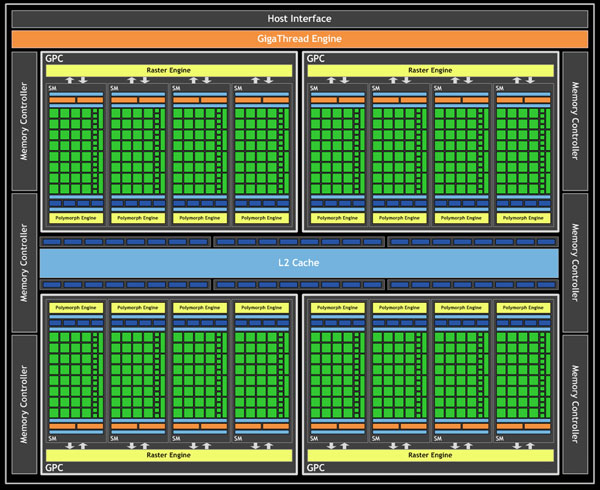
GF104 in turn contains 2 GPCs, which are effectively the same as a GF100 GPC. Each GPC contains 4 SMs and a Raster Engine. However when we get to GF104’s SMs, we find something that has all the same parts as a GF100 SM, but in much different numbers.
NVIDIA GF104 - Full Implementation, No Disabled Logic
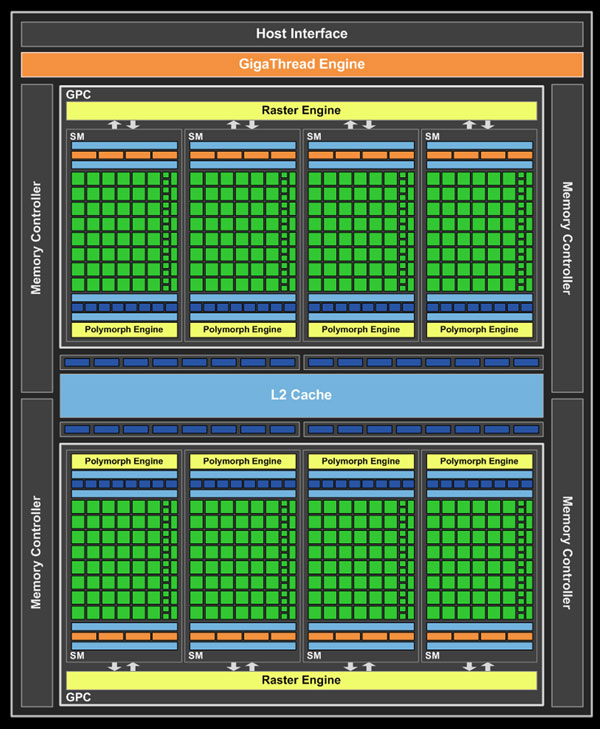
The biggest and most visible change is that NVIDIA beefed up the number of various execution units per SM. The 32 CUDA cores from GF100 are now 48 CUDA cores, while the number of SFUs went from 4 to 8 along with the texture units. As a result, per SM GF104 has more compute and more texturing power than a GF100 SM. This is how a “full” GF104 GPU has 384 CUDA cores even though it only has half the number of SMs as GF100.
One thing we haven’t discussed up until now is how an SM is internally divided up for the purposes of executing instructions. Since the introduction of G80 in 2006, the size of a warp has stayed constant at 32 threads wide. For Fermi, a warp is executed over 2 (or more) clocks of the CUDA cores – 16 threads are processed and then the other 16 threads in that warp are processed. For full SM utilization, all threads must be running the same instruction at the same time. For these reasons a SM is internally divided up in to a number of execution units that a single dispatch unit can dispatch work to:
- 16 CUDA cores (#1)
- 16 CUDA cores (#2)
- 16 Load/Store Units
- 16 Interpolation SFUs (not on NVIDIA's diagrams)
- 4 Special Function SFUs
- 4 Texture Units
With 2 warp scheduler/dispatch unit pairs in each SM, GF100 can utilize at most 2 of 6 execution units at any given time. It’s also because of the SM being divided up like this that it was possible for NVIDIA to add to it. GF104 in comparison has the following:
- 16 CUDA cores (#1)
- 16 CUDA cores (#2)
- 16 CUDA cores (#3)
- 16 Load/Store Units
- 16 Interpolation SFUs (not on NVIDIA's diagrams)
- 8 Special Function SFUs
- 8 Texture Units
This gives GF104 a total of 7 execution units, the core of which are the 3 blocks of 16 CUDA cores.
GF104 Execution Units
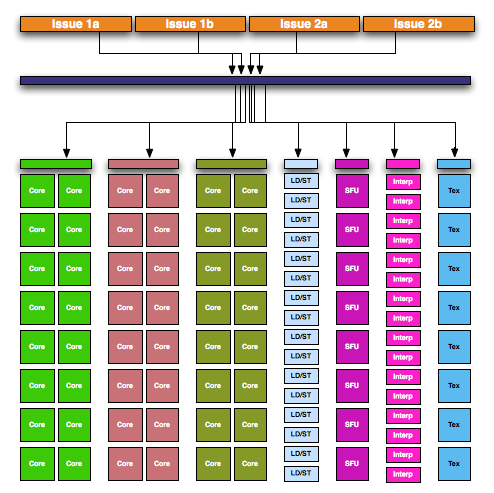
With 2 warp schedulers, GF100 could put all 32 CUDA cores to use if it had 2 warps where both required the use of CUDA cores. With GF104 this gets more complex since there are now 3 blocks of CUDA cores but still only 2 warp schedulers. So how does NVIDIA feed 3 blocks of CUDA cores with only 2 warp schedulers? They go superscalar.
In a nutshell, superscalar execution is a method of extracting Instruction Level Parallelism from a thread. If the next instruction in a thread is not dependent on the previous instruction, it can be issued to an execution unit for completion at the same time as the instruction preceding it. There are several ways to extract ILP from a workload, with superscalar operation being something that modern CPUs have used as far back as the original Pentium to improve performance. For NVIDIA however this is new – they were previously unable to use ILP and instead focused on Thread Level Parallelism (TLP) to ensure that there were enough warps to keep a GPU occupied.
NVIDIA GF100 SM
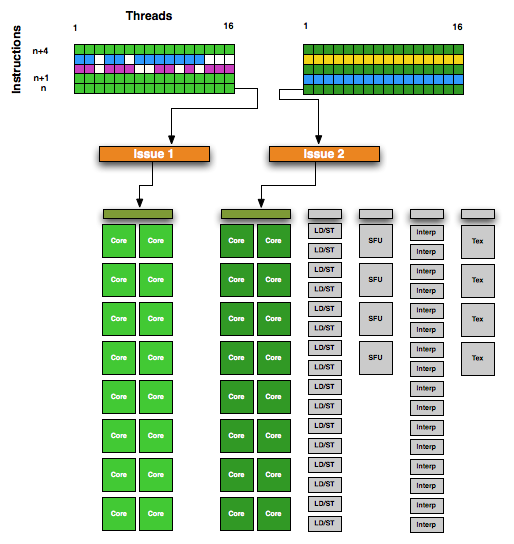
In order to facilitate superscalar operation, NVIDIA made some changes to both the warp scheduler and the dispatch unit for GF104. Each warp scheduler is now connected to 2 dispatch units, giving it the ability to dual-issue instructions. Along with its regular duties, a warp scheduler is now responsible for organizing its superscalar operation by analyzing the next instruction in its warp to determine if that instruction is ILP-safe, and whether there is an execution unit available to handle it. The result is that NVIDIA’s SMs now handle superscalar operation similar to that of a CPU, with the hardware taking the responsibility for dispatching parallel instructions. This in turn means that GF104 can execute a warp in a superscalar fashion for any code and including old CUDA code, allowing it to extract ILP out of old and new code alike. The GF104 compiler in NVIDIA’s drivers will try to organize code to better match GF104’s superscalar abilities, but it’s not critical to the ability.
NVIDIA GF104 SM - Note, more instructions in flight per SM vs. GF100
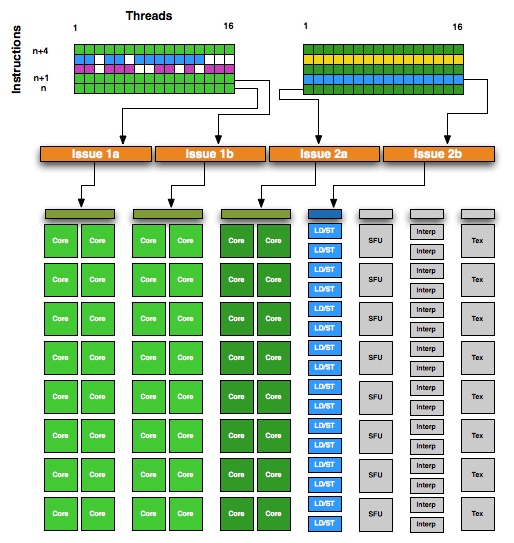
Ultimately superscalar execution serves 2 purposes on GF104: to allow it to issue instructions to the 3rd CUDA core block with only 2 warps in flight, and to improve overall efficiency. In a best-case scenario GF104 can utilize 4 of 7 execution units, while GF100 could only utilize 2 of 6 execution units.
The upside to this is that on average GF104 should be more efficient per clock than GF100, which is quite a remarkable feat. The downside to this is that now NVIDIA has a greater degree of best and worst case scenarios, as requiring superscalar execution to utilize the 3rd CUDA core block means that it’s harder to use that 3rd block than the previous 2. The ability to extract ILP from a warp will result in GF104’s compute abilities performing like a 384 CUDA core part some of the time, and like a 256 CUDA core part at other times. It will be less consistent, but on average faster than a pure 256 CUDA core part would be.
With the addition of superscalar abilities, GF104 marks the slow-but-steady merger of the CPU and the GPU. GF104 is now just a bit more CPU-like than GF100 was, a particularly interesting turn of events since we’re looking at a waterfall part and not a new architecture today.










93 Comments
View All Comments
jfelano - Monday, July 12, 2010 - link
I've already seen 5830's at $170 after rebate. So there goes that short lived Nvidia advantage.itsmekirill - Monday, July 12, 2010 - link
IMO the most important story here is not that it beats the HD 5830 or GTX 465, but that the SLI configuration is trading blows with 5870 CF and 5970.For ~450 dollars you can get comparable if not superior performance to an $800 CF setup or a $650 dollar 5970.
tcnasc - Monday, July 12, 2010 - link
Yes, that's what got me too!My 5870 feels so expensive right now
Should I sell it and buy 2 GTX 460?
fausto412 - Monday, July 12, 2010 - link
i didn't miss that...i got my 5870 3 weeks ago and i was like "wtf...this is a 200 dolalr card, it shouldn't do that well!"VIDYA - Monday, July 12, 2010 - link
good review but a bit partial towards the new born child(gtx 460, cant hold that kind of joy).......its pretty much still oranges and apples .....both are good and differ at a few games. Nvidia shouldn't have sold 480, 470, 465 and instead should be waiting back to mature the chip into 104gf.....think about the owners of gf100 chip reading this and cursing themselves for not holding back for a month. But all said and done from both sides, we all know that Nvidia is still no:1 when it comes to drivers and software support updates.SongEmu - Monday, July 12, 2010 - link
The quality and depth of these articles is exactly why I keep Anandtech bookmarked.Also, it's good to see nVidia with its headon straight. I was afraid I'd have to give up CUDA and all those other goodies on my next upgrade, because there was no way in GF100-hell I was going to buy a GTX470 toaster.
sparkuss - Monday, July 12, 2010 - link
I thought I looked at all the charts and I also didn't see any mention in the conclusion of 5850 CF vs the 460 1GB. Then again I'm old and senile so I have that going for me!I know the price differences but I would still like to see the comparison, especially if this could actually cause AMD to lower 5850 prices.
7Enigma - Tuesday, July 13, 2010 - link
Agreed. That would probably be the most common CF setup and certainly the most applicable from a cost-comparison standpoint. Sure it would be $600 vs. $400 but why have the 5870 CF which is even more crazy at $800 vs. $400?rocky12345 - Monday, July 12, 2010 - link
I read the review & it was pretty good & well written. It is good to see Nvidia get their act together somewhat. I am not a Nvidia fan any more lost faith in them when they started rebranding the 8800 series over & over again & I switched to ATI after that. I still have a 9800GT 1GB in one of my systems which I rebadged myself from a 8800GT 1GB & clocked it at 755Mhz core & 2200mhz memory it is fast enough for my secondary system for when friends come over to game.This new chip from nvidia makes a lot more sense than what they released a few months ago. Would I own on hell no. I already have enough money tied up in video cards in my main system as I own 2 4870x2 2GB cards highly over clocked crossfired until ATI comes out with a single card that can beat my 2 beasts in quad GPU I am fine with what I have.
Belard - Monday, July 12, 2010 - link
Right on, the GTX 460-768 should be a 455, its so NOT the same card.For the most part... why is idiot-Nvidia even bothering with the "GTX" part since their model numbers don't collide? ie: there won't be a GTX 460 and a GTS 460 or a GT 460... well, maybe... who knows.
The two 460's is designed EXACTLY to do what its going to do. People will buy the cheaper junk card and not get the performance they should get if they only spent $30 more.
Considering the age of the ATI 5000 series... it really should be EASY for ATI to reduce the prices of the line a bit.
The 5850 should be a $200 card by now. 5830 at $150, 5770 at $125... perhaps soon. 6000s come out just before Christmas?